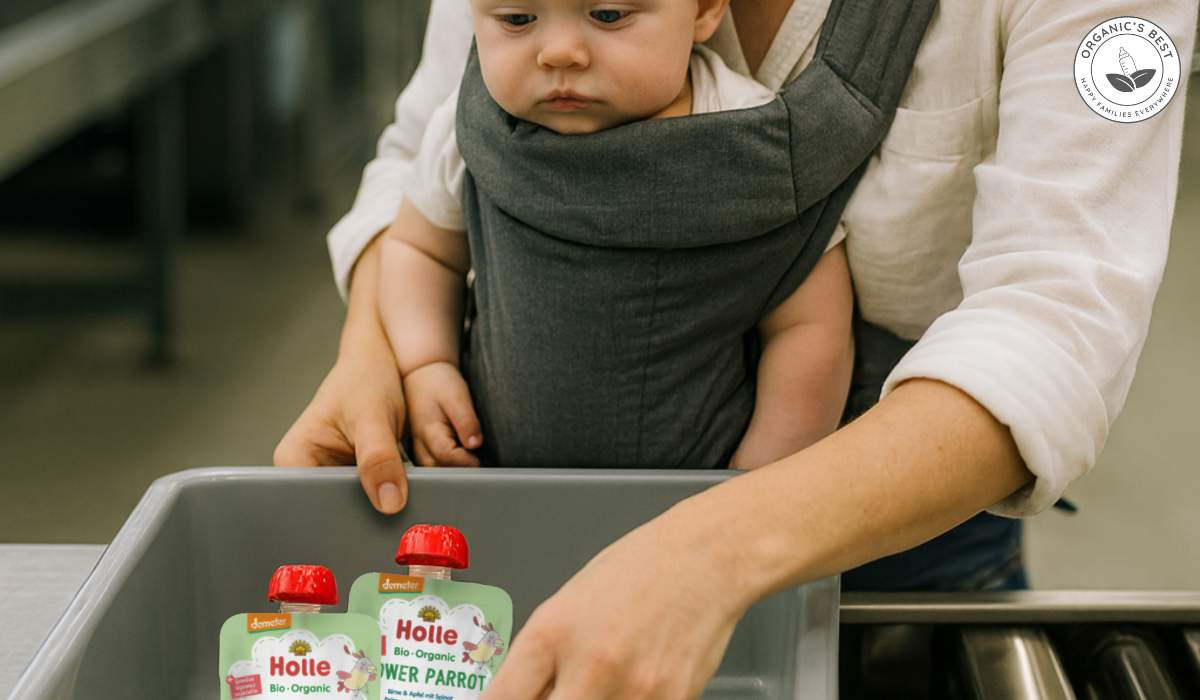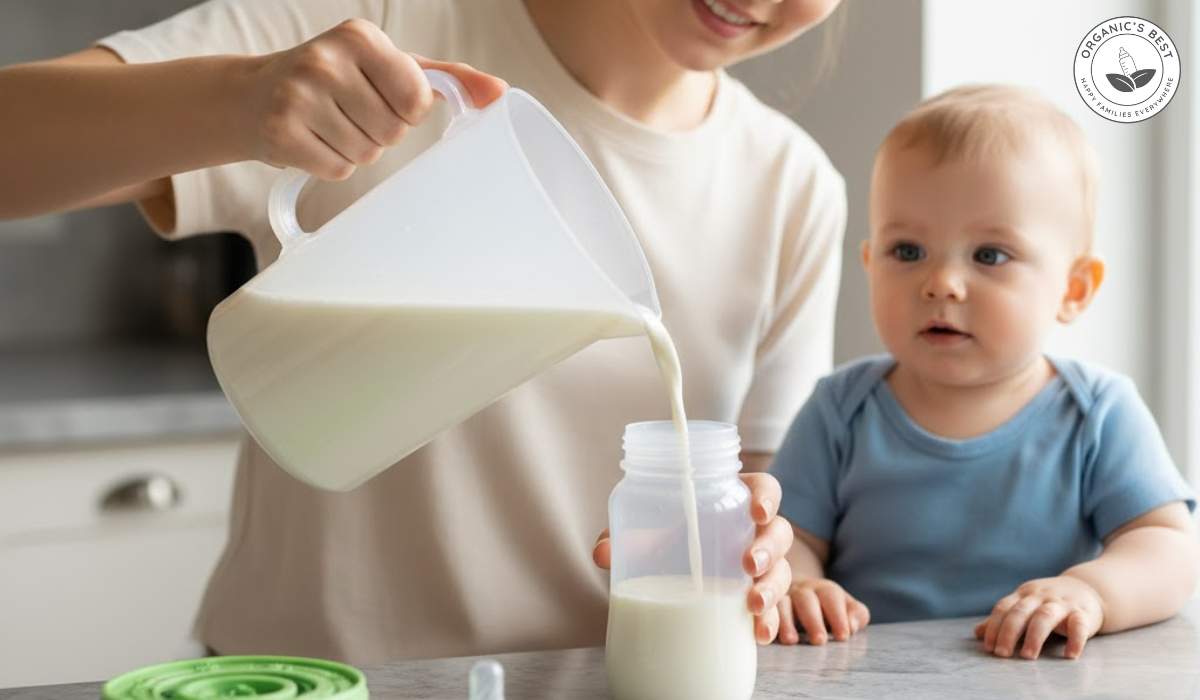Click to Get 2 FREE Boxes/Cans
Only New Customers! Click HERE to Get 2 Extra Boxes/Cans for Free With Your First Order.
BABY FORMULA
Offering new parents top-quality European infant formula from renowned brands like HiPP, Holle, Kendamil, and more. If you’re uncertain about which product to choose, our Formula Finder can help you make the best decision for your baby.
Baby Food
Offering new parents a premium selection of European baby foods, including jars, pouches, cereals, and snacks from esteemed brands like HiPP and Holle.
Essential Guide to Baby Massage for Soothing Comfort and Bonding
by Agustina Fernandez May 20, 2025 7 min read

Few moments are as precious as those early bonding times with your baby. While mama certainly deserves her moments of self-care during those demanding first months, setting aside intentional time to bring peace and comfort to your baby is equally vital.
Their journey into the world is demanding, with their tiny bodies undergoing significant growth and development. Gentle massages can truly enhance both their physical and emotional well-being during this critical period.
If you're interested in incorporating infant massage into your baby care routine, read on. We'll share practical ways to seamlessly integrate it into your daily schedule and offer tips on using massage to address specific discomforts your little one may experience.
Table of Contents
- Introduction to Infant Massage
- How to Massage a Baby
- What Are the Benefits of Baby Massage?
- When Should You Start Massaging Your Baby?
- Baby Massage for Gas
- Baby Massage for Constipation
- Baby Massage for Colic
- Baby Massage for Sleep
- Massaging Different Body Parts of Your Little One
- Reading Baby's Signals While Massaging
- Tips for Baby Massage Techniques
- Safety Precautions: What Not to Do During Baby Massage?
- Final Thoughts on Comforting Your Baby with a Massage
Introduction to Infant Massage
Infant massage has a rich history that stretches back thousands of years, with roots in ancient Asian and Pacific Island cultures dating as far back as 3,000 years ago. Traditionally, it's been a gentle way to soothe babies and support their transition from womb to world, offering both physical and emotional comfort.

In more recent years, this age-old practice has gained popularity in the Western world, as parents discover its many benefits. From easing digestive discomfort to improving sleep and deepening the parent-baby bond, incorporating massage into a daily routine is becoming a cherished part of modern baby care.
These benefits aren't just based on anecdotal evidence; there's solid research to back them up. Studies have shown that infant massage can positively impact a baby's growth, strengthen the bond between mother and child, and even boost a mother's confidence in caring for her little one.
Research published in the National Library of Medicine also states that "infant massage has been used in neonatal intensive care units to some benefit for various outcomes such as weight gain, reduced length of stay at hospital and postnatal complications".
How to Massage a Baby
While it is a common practice, it is natural to feel a little hesitant, after all, babies are so teeny tiny, and we often associate massage with deep pressure and intensity.
At first glance, it might seem like the two don't quite go together. But infant massage is a completely different experience. It's incredibly gentle, using soft pressure and simple, soothing strokes designed to calm and comfort your baby.
What Are the Benefits of Baby Massage?
Before we dive into how to perform a baby massage, let's focus on why it is so widely practiced.
One of the most powerful aspects of infant massage is how it naturally promotes skin-to-skin contact, sometimes referred to as kangaroo care. This close physical connection offers a wide range of benefits for both baby and parent.
Here's a quick overview of how skin-to-skin contact can help:
-
Lowers stress for both baby and parent
-
Enhances breastfeeding and fosters a stronger emotional bond
-
Strengthens connection through touch, smell, sight, and sound
-
Aids in regulating baby's body temperature, heart rate, breathing, and oxygen levels
-
Supports digestion and boosts the immune system
-
Encourages longer, deeper sleep and more alert, quiet moments
-
Helps increase milk production in breastfeeding moms
-
Contributes to reducing postpartum bleeding in mothers
On top of the benefits received from skin-to-skin, the massage itself hosts a number of benefits as well:

-
Massage helps lower stress hormones and encourages relaxation in babies
-
It supports body awareness, coordination, and healthy digestion, while also easing common tummy troubles
-
Studies link infant massage to improved sleep patterns and less frequent crying
-
It helps parents feel more confident, connected, and attuned to their baby's needs
-
When practiced regularly, baby massage can create a calmer, more peaceful home environment for the entire family
When Should You Start Massaging Your Baby?
You can begin massaging your baby as early as the first few weeks after birth, once both you and your little one have settled into a bit of a rhythm.
For a newborn massage, it's best to start slowly with very gentle strokes and keep sessions short, just a few minutes at a time, until they become more comfortable with the sensation.
If your baby was born prematurely or has any health concerns, it's a good idea to check in with your pediatrician before getting started. In general, as long as your baby is healthy and you're following their cues, infant massage can be safely introduced early on and adapted as they grow.
Baby Massage for Gas
Gas is a common issue in newborns and young babies, usually caused by their immature digestive systems getting used to processing milk or formula efficiently. Gentle infant massages for gas, focusing on the tummy area, can help release trapped air and move it through the digestive tract, offering sweet relief to your little one.
Tip: For a baby gas massage, use gentle, clockwise circles on your baby's tummy, or try the I love you massage baby technique to follow the natural path of the intestines. You can also gently press the knees toward the tummy to help release gas.
Baby Massage for Constipation
Constipation can make your baby uncomfortable and cranky, especially when bowel movements are infrequent or difficult to pass. An infant massage for constipation, or as some call it, a baby poop massage can help by stimulating bowel movements and relaxing the intestinal muscles.
Tip: If you're using a massage to help baby poop, you should apply gentle pressure in small, clockwise circles below the belly button. Try bicycling baby's legs to activate the lower abdomen and encourage bowel movement.
Baby Massage for Colic
The cause of colic is often a mystery, defined by long bouts of crying in an otherwise healthy baby. It's believed to be linked to digestive discomfort, overstimulation, or a still-developing nervous system. Massage can provide comfort by calming the nervous system and aiding digestion.
Tip: Use slow, gentle strokes on the tummy and chest in a quiet, low-light space. A warm bath before the massage can help your baby relax even more.
Baby Massage for Sleep
Many parents find that a bedtime massage helps their baby fall asleep faster and stay asleep longer. It's a soothing ritual that helps signal that it's time to wind down.
Tip: After bath time, use long, calming strokes down the arms, legs, and back in a quiet, dimly lit room. Keep it slow and soothing to signal it's time for rest.
Massaging Different Body Parts of Your Little One
From fuzzy heads to wiggly toes, each part of your baby's body can benefit from gentle, loving touch. Here's how to approach each area with care:
Baby's Feet and Toes
Use light circular motions on the soles and toes to relax and ground your baby. Avoid pressing too close to the ankles. Foot massage can help ease tension and support overall calm.
Baby's Head and Face
Gently stroke the scalp, forehead, and cheeks with soft fingertips. Be extra gentle around the eyes and mouth. This can soothe your baby and may even support healthy hair growth.
Baby's Arms and Hands
Massage from the shoulders down to the wrists using light, circular motions. Gently press the palms and avoid tugging on fingers. This helps with relaxation and sensory development.
Baby's Legs and Hips
Start with gentle strokes from the thighs to the ankles. Use soft pressure on calves and thighs, steering clear of the knees. This can ease tightness and support healthy circulation and movement.
Baby's Tummy
For a baby tummy massage, use slow, clockwise circular motions on your baby's tummy to relieve gas and promote digestion. Avoid pressing too hard, especially if your baby has a sensitive belly. This can help ease discomfort and support tummy health.
Reading Baby's Signals While Massaging
Baby massage is generally safe and loved by most babies, but always let your baby guide the experience. If they seem fussy or upset, pause and check if they're comfortable, as some babies may find extra stimulation overwhelming.
Look for signs of relaxation, like a calm face and relaxed body, to know they're enjoying it. Adjust your touch as needed, making strokes lighter or focusing on different areas.
If your baby remains uncomfortable, respect their boundaries and stop the massage, and this will promote an experience of trust and comfort.
Tips for Baby Massage Techniques
-
Keep it soft and steady: Use gentle, flowing strokes to create a calm, soothing atmosphere for your baby.
-
Be gentle around sensitive areas: Light pressure is important, especially around the face, tummy, and joints.
-
Reduce friction: Use a baby massage oil or lotion to help your hands move smoothly, making the experience more comfortable for your little one.
-
Switch things up: Keep your baby's attention by trying different techniques. You can try circular motions, gentle squeezes, or even light tapping to mix it up.
Safety Precautions: What Not to Do During Baby Massage?

Giving your little one a massage doesn't need to be complicated, but there are a few things to keep in mind.
Before starting, it's a good idea to consult your healthcare provider, especially if your baby has any health concerns.
Avoid massaging your baby if they're hungry, tired, or overstimulated. Instead, wait until they're calm so they can associate massage with relaxation and an overall positive experience.
Be sure to use gentle pressure and soft strokes; too much pressure can be uncomfortable for your baby.
Finally, always keep the massage area clean, avoiding harsh chemicals or fragrances that could irritate their sensitive skin.
Final Thoughts on Comforting Your Baby with a Massage
All of that to say, infant massage is a beautiful way to foster bonding and provide comfort for your baby.
Parents and healthcare professionals all over the world agree that by adding massage to your daily routine, you create a calming, loving experience that strengthens your little one's physical and emotional well-being.
|
Disclaimer: Please be aware that this information is based on general trends in babies, and it is not medical advice. Your doctor should be your first source of information and advice when considering any changes to your child’s formula and when choosing your child’s formula. Always consult your pediatrician before making any decisions about your child’s diet or if you notice any changes in your child. Breastfeeding is the best nutrition for your baby because breast milk provides your child with all the essential nutrients they need for growth and development. Please consult your pediatrician if your child requires supplemental feeding. |
Agustina Fernandez
Dr. Agustina Fernandez earned her medical degree from the prestigious Universidad Nacional de Córdoba, Argentina. With a deep-rooted passion for pediatrics, Dr. Fernandez is currently on the path to specializing in children's healthcare. Recently, she has delved into the vital field of infant nutrition. Her research interests include breastfeeding, infant formula, and baby food in little ones’ formative years. Dr. Fernandez's commitment to this area of study underscores her dedication to ensuring the health and well-being of children from their earliest days.
Leave a comment
Comments will be approved before showing up.
Also in Organic Infant Nutrition and Health Blog

Everything You Need To Know About Winter Pregnancy: Essential Tips for Moms-to-be
by Agustina Fernandez December 16, 2025 8 min read
Read More
Can You Bring Baby Food Pouches on a Plane? Essential Tips for Parents
by Agustina Fernandez December 09, 2025 7 min read
Read More
The Formula Pitcher: Is It Safe To Make A Whole Pitcher Of Baby Formula?
by Agustina Fernandez December 02, 2025 8 min read
Read More
Reviewed by Dr. Bardha Citaku, MD
-

Dr. Bardha Citaku: Medical Reviewer of Organic's Best Blog
Dr. Bardha Citaku completed her medical studies at the University of Prishtina in Kosovo, where she began her journey into the field of medicine. She has since developed a career in medical research, contributing to projects with notable organizations, including the World Health Organization (WHO).
